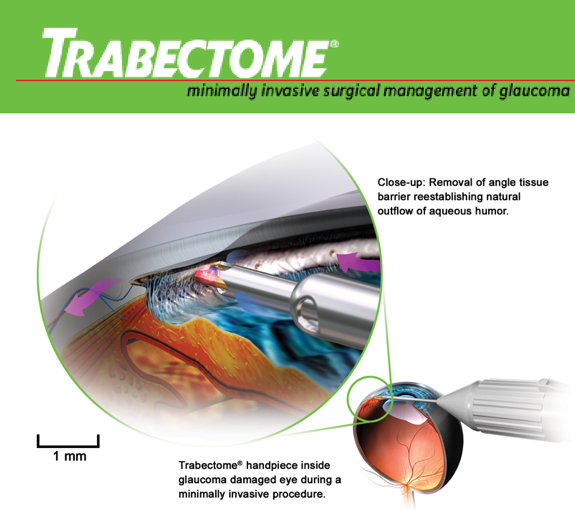What is glaucoma?
Glaucoma is a group of diseases causing damage and deterioration to the optic nerve. It is the leading cause of blindness in people over 40 years old. Fortunately, today, glaucoma treatments are better than ever. The optic nerve is the cable that carries information about what your eyes see to the brain where it is processed. In most glaucoma cases, fluid inside the eye builds up causing an increase in intraocular pressure. While it is not fully understood, it is thought that this increase in pressure damages the individual nerve fibers within the optic nerve. When left untreated this damage progresses over time and can lead to blindness.
Types of glaucoma
There are two main categories of glaucomas: open-angle glaucoma and angle-closure glaucoma.
Open-angle glaucoma is the most common type of glaucoma. It is classified by a buildup of fluid likely due to a clogged or poorly functioning drainage angle (called the trabecular meshwork). This type of glaucoma has previously been termed a “silent blinder” as it is painless and causes no visual symptoms at first. Open-angle glaucoma is usually diagnosed during routine eye health examinations.
Angle-closure glaucoma is less common than open-angle glaucoma. In this condition, pressure inside the eye spikes because the drainage angle becomes very narrow or closed, blocking fluid from leaving the eye. When the drainage angle closes, intraocular pressure can rise quickly, which makes this condition an emergency. Unlike open-angle glaucoma, acute angle-closure glaucoma can produce symptoms of redness, pain, light sensitivity, nausea, and blurred vision.
Risk factor
In general, glaucoma impacts about one percent of the world’s population. There are several known risk factors for glaucoma. These include:
- Age over 40
· Race of African American, Hispanic, or Asian
- Positive family history
- High eye pressure
- History of eye injury
- Having thin corneas
- Being nearsighted or farsighted
Diagnosis
To diagnose glaucoma, a doctor will order several tests to evaluate your risk. The first test done will be to measure your eye pressure. While glaucoma is correlated to having high eye pressure, some patients with normal eye pressure may also develop glaucoma. Other tests include a threshold visual field, pachymetry to measure corneal thickness, optical coherence tomography laser (OCT) scanning of the optic nerve, and a dilated eye exam to assess any glaucoma-like changes to the optic nerve. Once all this data is collected, the doctor will evaluate these tests together to determine a risk and proper treatment.
Symptoms of glaucoma
There are usually no symptoms of high eye pressure, which is why regular eye exams are so important. In advanced glaucoma patients may notice a reduction in peripheral vision, progressing to tunnel vision. Acute open-angle glaucoma has additional symptoms of redness, pain, nausea, light sensitivity, and blurred vision.

Treatments
Treatment for glaucoma is catered to lowering the intraocular pressure. Once glaucoma is diagnosed, a personalized treatment plan will be established for every patient, based on the type and severity of the condition. Glaucoma may be treated with eye drops, laser and conventional surgery, or both. Eye drops are the most common management for glaucoma, as they generally do a very good job of lowering the eye pressure. In patients who struggle with instillation of drops or who aren’t getting the necessary pressure lowering effects, surgery may be indicated. Laser surgeries are simple, minimally invasive procedures done on an outpatient basis and have a low risk of side effects. In cased of advanced glaucoma, conventional surgical methods may be necessary. These procedures create a new drainage channel for aqueous fluid to leave the eye.
Many surgeons are now performing a new group of glaucoma surgeries, called minimally invasive glaucoma surgery (MIGS). This is done in conjunction with cataract surgery and involves a stent being carefully placed in the drainage angle to allow passage of aqueous fluid. These stents can help to lower eye pressure and may reduce the number of drops patients are taking.






